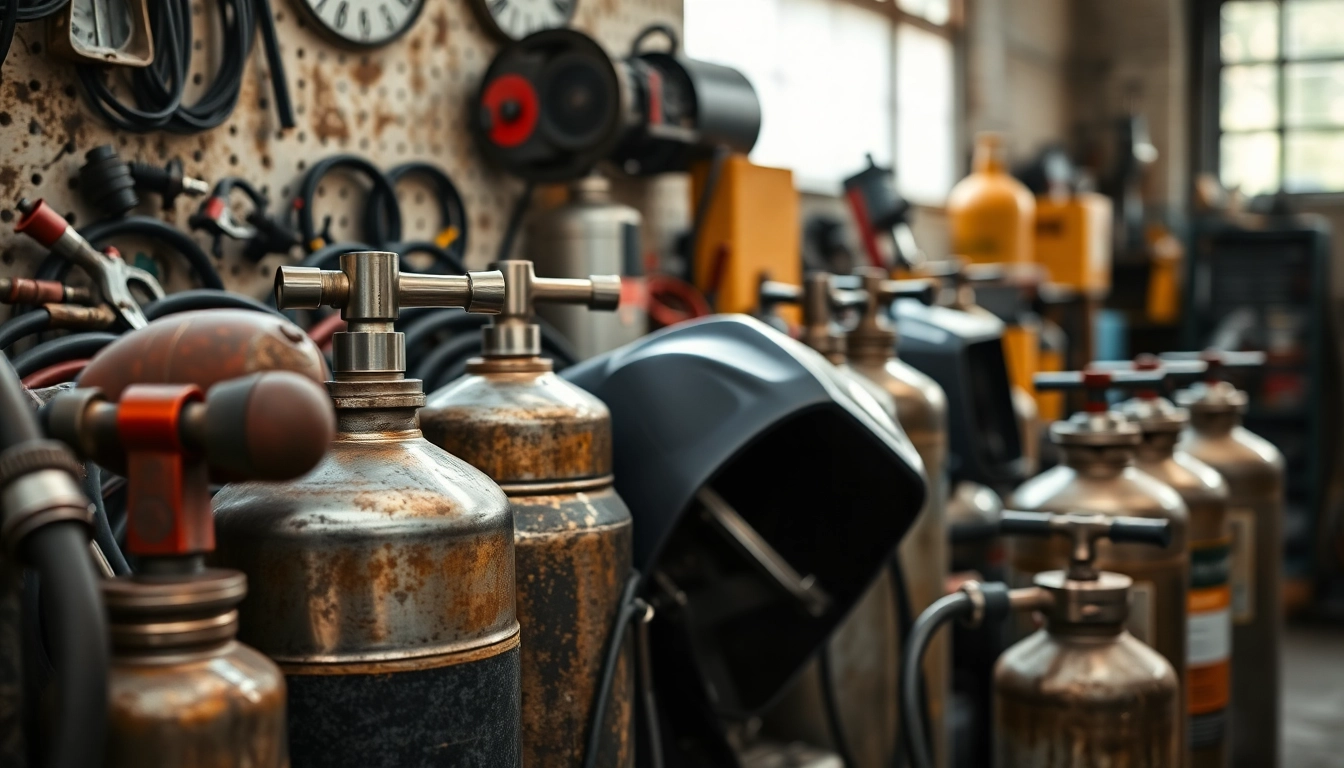Understanding the Basics of Oxy Acetylene Welding Kits
What is an Oxy Acetylene Welding Kit?
Oxy acetylene welding is a welding process that utilizes the combustion of oxygen and acetylene gas to produce a flame hot enough to melt metal. This method is commonly used in welding and cutting applications due to its versatility and efficiency. An oxy acetylene welding kit is essentially a set of equipment designed for this process, allowing users to join different types of metals with precision. It’s popular among hobbyists and professionals alike because it combines the ability to weld, cut, and heat various materials.
Oxy acetylene kits can be found in various sizes and configurations, accommodating different applications, from intricate metalwork in art to heavy-duty welding tasks in construction. A well-assembled kit can make the difference between a successful project and a frustrating one.
Components of an Oxy Acetylene Welding Kit
A typical oxy acetylene welding kit includes several key components, each serving a specific purpose:
1. Gas Cylinders: These are essential for storing the oxygen and acetylene gases. The oxygen cylinder is generally green, while the acetylene cylinder is typically red. Proper handling and storage of these cylinders are crucial for safety.
2. Regulators: These devices attach to the gas cylinders and help control the pressure of the gases being released. Accurate adjustments ensure the proper flame characteristics during welding.
3. Hoses: The colored hoses transport the gases from the cylinders to the torch. Typically, the oxygen hose is green, and the acetylene hose is red. Ensuring these hoses are in good condition is vital to prevent leaks.
4. Welding Torch: The torch is where the gases mix and ignite, producing the flame used for welding. Different tips can be attached to vary the flame size.
5. Cutting Attachment: This can be added to the welding torch for cutting metals, thus enhancing the kit’s versatility.
6. Protective Gear: Safety glasses, gloves, and a welding mask are crucial for protecting the user from sparks and harmful UV rays during the welding process.
Understanding these components is essential for anyone looking to use an oxy acetylene welding kit effectively and safely.
How Oxy Acetylene Works for Welding
The process of oxy acetylene welding begins with the correct setup of the equipment. When the gases are ignited in the welding torch, they combine to create a flame between 3,000°F (1,650°C) and 6,300°F (3,480°C), which is hot enough to melt most metals.
The welder controls the flame by adjusting the flow rates of oxygen and acetylene through the regulators. There are two primary types of flames used in oxy acetylene welding: the neutral flame, characterized by a clear inner cone, which is approximately equal portions of both gases; the oxidizing flame, which has a shorter inner cone and more oxygen; and the carburizing flame, which has a longer inner cone and excess acetylene. Each flame type serves specific purposes, with the neutral flame being most commonly used for welding and cutting operations.
Furthermore, welders often manipulate the torch’s tilt and the speed at which they move it along the workpiece to achieve different weld profiles and depths. Mastering these techniques is crucial for producing effective welds.
Benefits of Using an Oxy Acetylene Welding Kit
Versatility in Applications
One of the primary advantages of oxy acetylene welding kits is their versatility. These kits can be used for various applications, including welding, cutting, brazing, and heating metals. This makes them ideal not only for industrial use but also for small workshops and hobbies.
For example, the ability to cut metal with oxy acetylene extends beyond welding. Many artists and metalworkers appreciate the precision the flame provides when sculpting or customizing parts. Similarly, this method is favored in automotive repair for its efficiency in metal joining.
Cost-Effectiveness and Efficiency
Investing in an oxy acetylene welding kit can be cost-effective because it eliminates the need for multiple pieces of equipment. Rather than purchasing separate machines for cutting and welding, a single kit can fulfill multiple functions, saving both money and space.
Moreover, oxy acetylene is effective for thick materials, where other welding methods may falter. The high heat produced by the flame allows for rapid welding, significantly reducing project times, which is a considerable advantage in a commercial setting.
Accessibility for Beginners
Oxy acetylene welding is often recommended as an entry-level welding technique due to its relative simplicity. The components of an oxy acetylene welding kit are user-friendly, and with a bit of practice, beginners can quickly master the techniques required for successful welds.
Safety practices associated with oxy acetylene welding, while essential to learn, are also well-documented, giving new welders a wealth of resources to call upon. Online tutorials, community forums, and instructional videos can provide guidance for novices looking to get started with welding projects.
Selecting the Best Oxy Acetylene Welding Kit for Your Needs
Factors to Consider When Purchasing
When looking for the perfect oxy acetylene welding kit, consider the following factors to ensure you choose one that fits your requirements:
1. Purpose: Determine what you will primarily use the kit for—light welding tasks, heavy industrial work, or perhaps artistic purposes. This will affect the size and components you need.
2. Quality of Components: Validate that the cylinders, hoses, regulators, and torches are of high quality and meet recognized standards. Inferior components can be unsafe and lead to subpar results.
3. Portability: If you need to move your kit frequently, lighter and more compact options may be beneficial.
4. Cost: Compare prices across different brands and options. While it might be tempting to go for the cheapest option, remember that high-quality components may pay off in durability and performance.
5. User Reviews: Research and read reviews from other users. They can provide valuable insights into the performance and reliability of different kits.
Top Oxy Acetylene Welding Kits Reviewed
1. UNIMIG Oxygen Acetylene Gas Kit: Known for its comprehensive set-up, this kit is ideal for beginners and includes all necessary components. Users appreciate the sturdy construction and easy handling.
2. Harris HMD Medium Duty Ironworker Torch Kit: Retailing at around $99, this kit is noted for its excellent flame control and portability, making it a favorite for both DIY enthusiasts and professionals needing a reliable option for light to medium jobs.
3. OLSEN Heavy Duty Oxygen and Acetylene Welding Kit: This kit boasts robust capabilities for welding low to medium carbon steel, rated highly for quality and user satisfaction.
4. Grizzly Industrial Torch Kit: Praised for its build quality and precision, this kit includes essential accessories, making it a comprehensive choice for both beginners and experienced welders.
These reviews serve as a guideline; however, personal requirements should dictate your final choice.
Where to Buy an Oxy Acetylene Welding Kit
Purchasing an oxy acetylene welding kit can be accomplished through various channels. Online retailers such as Amazon often provide a wide selection, allowing you to compare prices, read customer reviews, and benefit from home delivery. Brick-and-mortar stores such as Home Depot and welding supply shops also stock these kits, allowing customers to see and feel the equipment before making a purchase.
Should you prefer a physically present inventory, local welding supply houses may provide a personalized experience, with staff trained to assist in finding the right kit for your needs.
Safety Tips for Using an Oxy Acetylene Welding Kit
Essential Safety Gear
Safety should always be a priority when using welding equipment. The following gear is recommended:
1. Welding Mask: A well-fitted welding mask that protects your eyes from harmful UV rays and bright flames is non-negotiable.
2. Gloves: Fire-resistant gloves should be worn to protect your hands from heat and sparks.
3. Protective Clothing: Long sleeves and pants made from flame-resistant materials can prevent burns from hot metal and sparks.
4. Footwear: Steel-toed boots are advisable to protect against heavy items or molten metal.
5. Respirators: For environments where fumes may be present, respirators are necessary to protect your lungs.
Proper Handling and Usage Practices
Using an oxy acetylene welding kit requires proper handling to ensure safe operation:
1. Setup: Ensure an adequate setup is conducted in a well-ventilated area, free from flammable materials.
2. Check for Leaks: Regularly inspect hoses and connections for leaks using soapy water to avoid dangerous gas leaks.
3. Store Cylinders Securely: Always store gas cylinders upright, secured with chains, and away from heat sources.
4. Post-Use Protocols: Always close the valves on gas cylinders when done and release any gas pressure in the lines to prevent buildup.
Adhering to these practices minimizes accident risks, ensuring a safer working environment.
Emergency Protocols in Case of Accidents
Even with sound safety practices, accidents can happen. Here’s what to do in various emergencies:
1. Fire: In case of ignition, use a fire blanket or an extinguisher rated for metal fires. Never use water on a metal fire.
2. Gas Leak: If you suspect a gas leak, immediately evacuate the area and contact emergency services. Inform them of the nature of the gases involved.
3. Burns: Administer first aid for burns by rinsing the affected area with cool water. For severe burns, seek medical assistance swiftly.
4. Inhalation of Fumes: If someone has inhaled toxic fumes, move them to fresh air and perform CPR if necessary, while waiting for emergency services.
Preparedness can make a significant difference in how a situation is handled during an emergency.
Advanced Techniques with Oxy Acetylene Welding Kits
Welding Different Materials
As you gain proficiency with an oxy acetylene welding kit, you can begin welding different materials, each demanding unique techniques:
1. Steel: The most common material, mild steel can be welded with standard techniques. Use a neutral flame for optimal results.
2. Aluminum: This requires a slightly different approach; a specific nozzle designed for aluminum, along with a higher temperature, is usually necessary.
3. Cast Iron: Welding cast iron demands a preheating stage since it can crack under pressure. Consider using special filler material designed for cast iron.
4. Copper and Brass: These materials can also be welded with oxy acetylene, but specific techniques and temperatures should be adapted to preventing overheating.
Understanding the properties of different metals can help you adjust your techniques accordingly and achieve better results.
Troubleshooting Common Issues
Even experienced welders can face problems. Here are some common issues and solutions:
1. Poor Flame Adjustment: A non-neutral flame can lead to weak welds. Check the gas flow rates and ensure a balanced mixture.
2. Excessive Spatter: This might indicate that the material is not prepped correctly, or the flame is too hot. Clean the base metals and reduce flame temperature.
3. Inconsistent Welds: Ensure you maintain a steady speed and angle when welding. Practice will improve consistency.
4. Gas Leaks: Inspect your equipment regularly for leaks. If a leak is discovered, replace the faulty components immediately.
Effective troubleshooting enhances welding quality and promotes safety.
Enhancing Your Skills with Practice Projects
To truly master an oxy acetylene welding kit, consider engaging in practice projects that offer varied challenges:
1. Simple Repairs: Start with repairing metal furniture or garden tools. This will help in getting used to the torch.
2. Artistic Projects: Creating sculptures or decorative metalwork can make practice enjoyable while letting you explore aesthetics.
3. Functional Items: Fabricate functional items like tool racks or bicycle frames. This adds practical experience and helps with design skill development.
By regularly practicing, you will increase your comfort and confidence with oxy acetylene welding, paving the way for more complex projects in the future.



